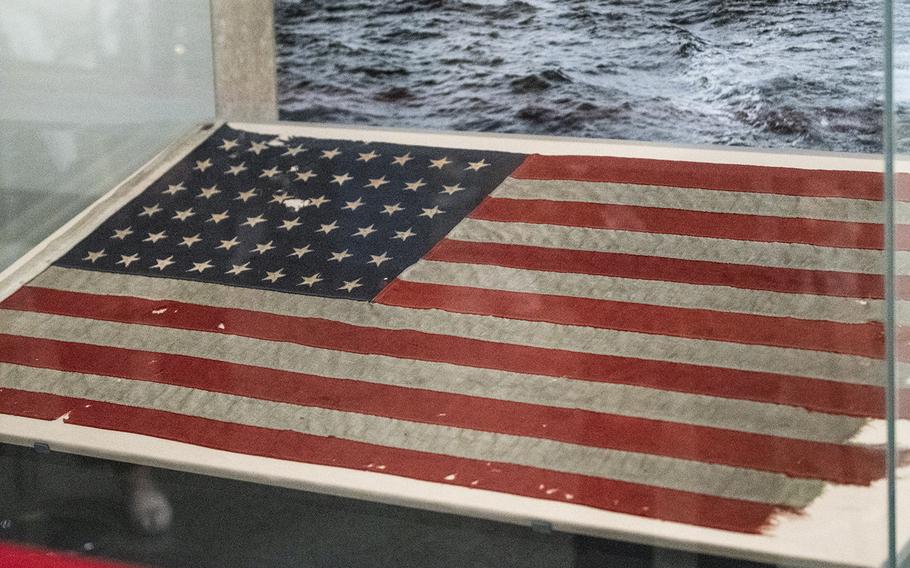
A flag that flew on a landing craft control vessel during the 1944 D-Day landings at Utah Beach, France, was unveiled at the Smithsonian National Museum of American History in Washington, D.C. on Friday, July 26. (Emma Swislow/Stars and Stripes)
WASHINGTON — More than 100 veterans gathered at the National Museum of American History on Friday to see the unveiling of a 48-star flag that flew on Landing Craft Control 60 during the 1944 D-Day assault on Utah Beach in Normandy.
Among those in attendance was Herman Zeitchik, who stormed Utah Beach on D-Day and later played a part in liberating both Paris and the Dachau concentration camp. Most of the other veterans in attendance served in Vietnam, and were in Washington as part of the Old Glory Honor Flight from northeast Wisconsin.
The flag is displayed on the third floor of the museum as part of an exhibition marking the 75th anniversary of D-Day.
During the invasion, LCC 60 guided American vessels to their landing spots on the beach and helped control the armada’s movement. After the events at Utah Beach and other fights in France, its flag was brought home by U.S. Navy Reserve Lt. j.g. Howard Vander Beek, who captained LCC 60. For years, Vander Beek, who was of Dutch descent, displayed the flag in his house, curator Jennifer Jones said.
After Vander Beek died in 2014, the flag went up for auction. Bert Kreuk, a collector from the Netherlands, purchased it through Heritage Auction in Texas in June 2016 with the intention of someday giving it back to the United States.
The flag was exhibited in the Netherlands for a couple years before Kreuk emailed the National Security Council and the State Department in November to let them know he wanted to return it to the U.S. He and his uncle, Theo Schols, then donated the flag to the museum.
“[The donors] were interested in giving the flag that they had purchased ... back to the United States and to the people of the United States because they had such a feeling of personal connection to the country,” Jones said. “They had been able to grow up and live the ‘American Dream’ because of Europe’s liberation in World War II.”
On the Fourth of July, according to Jones, the donors emailed the Smithsonian to let them know that Kreuk, alongside President Donald Trump and Dutch Prime Minister Mark Rutte, would present the flag at the White House during a ceremony on July 18.
The flag was flown from the Netherlands to Andrews Air Force Base, Md., on a military transport. The American History Museum then catalogued the object before loaning it to the White House for the ceremony.
Jones worked with designers and other curators at the museum to put together its space at the museum in order that it could be displayed just a week after its appearance at the White House. Typically this process takes six months at minimum, Jones said.
Among the flag’s features that Jones hopes to explore more are the holes throughout it.
“We want to know which holes in the flag might be attributed to machine gun fire by the Germans,” Jones said. “There’s one little pinhole that’s very clean and doesn’t have a lot of fraying around it. I’m suspecting there’s more than one, but I’d love to be able to talk to [Vander Beek’s] family to know more.”
The flag will be displayed for a year as part of the D-Day exhibition and then move to the museum’s permanent collection, Jones said.